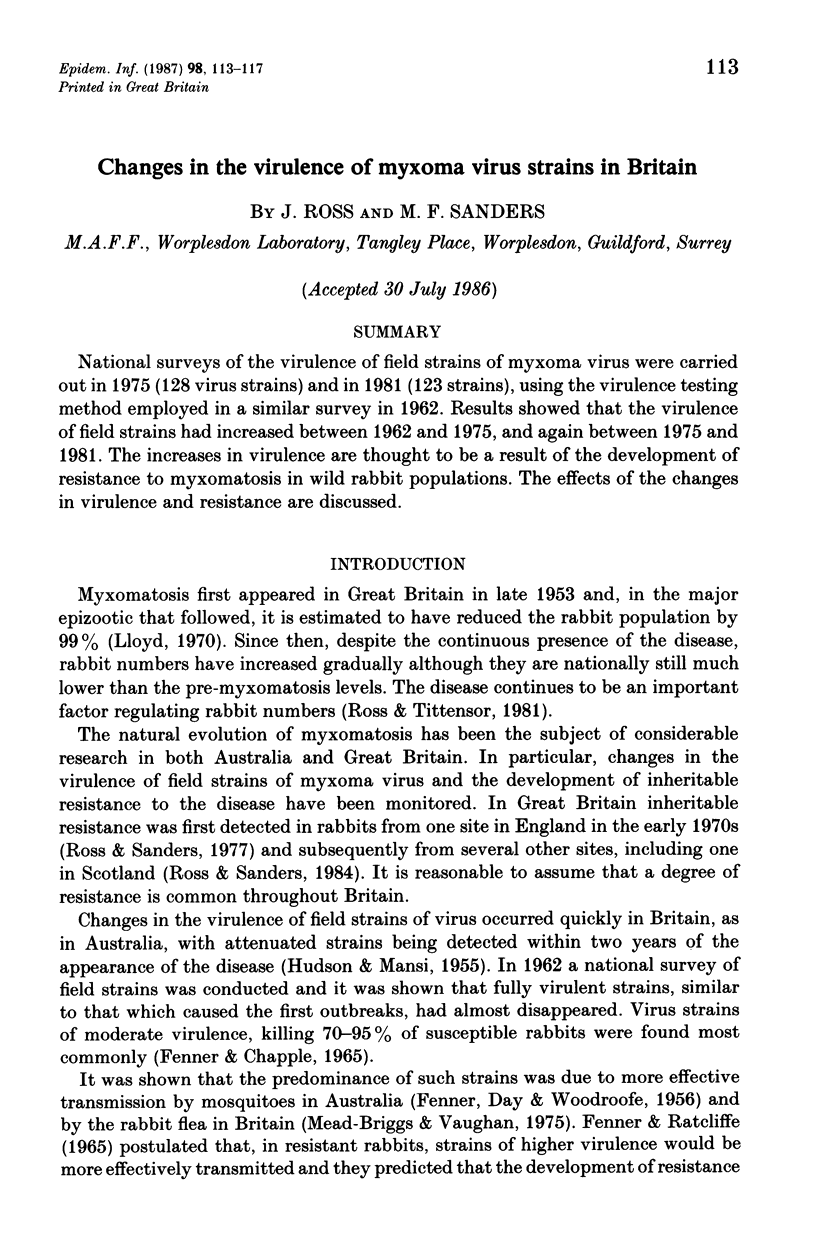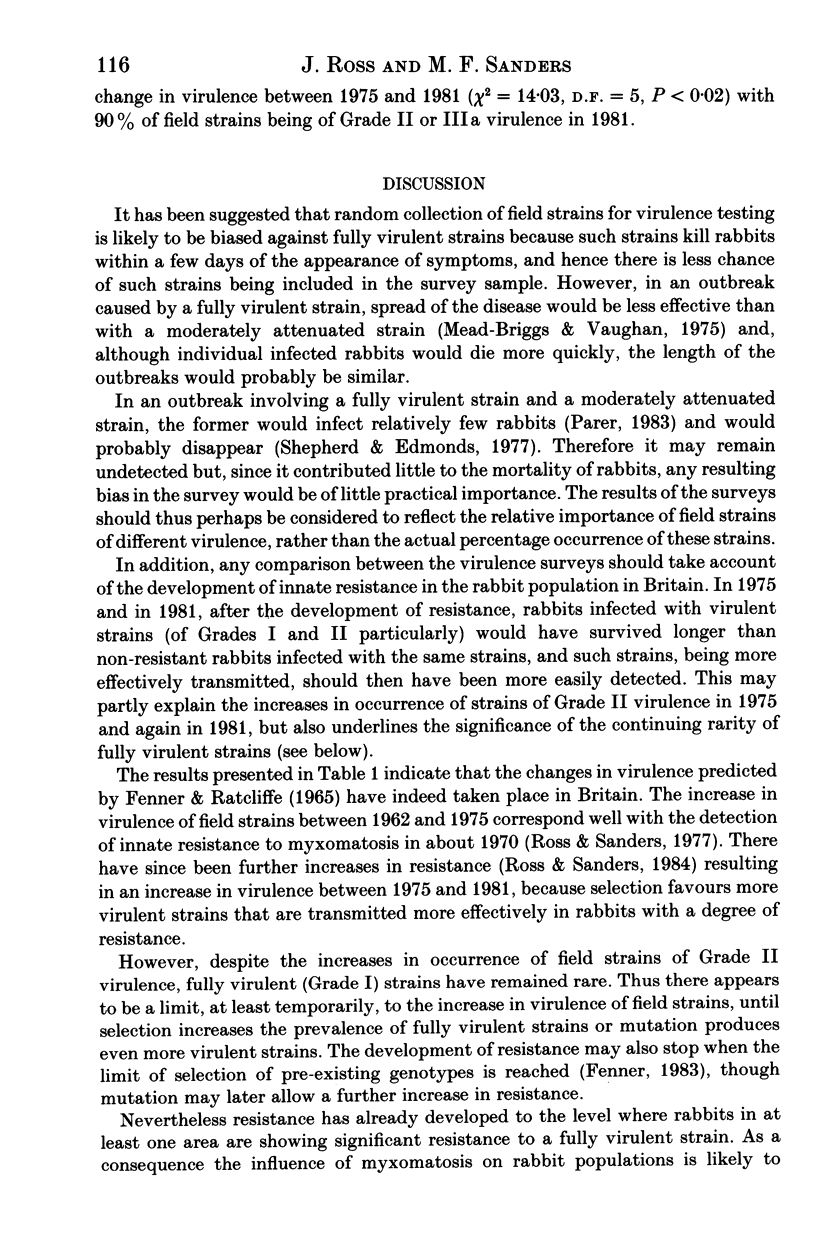Abstract
National surveys of the virulence of field strains of myxoma virus were carried out in 1975 (128 virus strains) and in 1981 (123 strains), using the virulence testing method employed in a similar survey in 1962. Results showed that the virulence of field strains had increased between 1962 and 1975, and again between 1975 and 1981. The increases in virulence are thought to be a result of the development of resistance to myxomatosis in wild rabbit populations. The effects of the changes in virulence and resistance are discussed.
Full text
PDF




Selected References
These references are in PubMed. This may not be the complete list of references from this article.
- Edmonds J. W., Nolan I. F., Shepherd R. C., Gocs A. Myxomatosis: the virulence of field strains of myxoma virus in a population of wild rabbits (Oryctolagus cuniculus L.) with high resistance to myxomatosis. J Hyg (Lond) 1975 Jun;74(3):417–418. doi: 10.1017/s0022172400046921. [DOI] [PMC free article] [PubMed] [Google Scholar]
- FENNER F., CHAPPLE P. J. EVOLUTIONARY CHANGES IN MYXOMA VIRUS IN BRITAIN. AN EXAMINATION OF 222 NATURALLY OCCURRING STRAINS OBTAINED FROM 80 COUNTIES DURING THE PERIOD OCTOBER-NOVEMBER 1962. J Hyg (Lond) 1965 Jun;63:175–185. doi: 10.1017/s0022172400045083. [DOI] [PMC free article] [PubMed] [Google Scholar]
- FENNER F., DAY M. F., WOODROOFE G. M. Epidemiological consequences of the mechanical transmission of myxomatosis by mosquitoes. J Hyg (Lond) 1956 Jun;54(2):284–303. doi: 10.1017/s0022172400044521. [DOI] [PMC free article] [PubMed] [Google Scholar]
- FENNER F., MARSHALL I. D. A comparison of the virulence for European rabbits (Oryctolagus cuniculus) of strains of myxoma virus recovered in the field in Australia, Europe and America. J Hyg (Lond) 1957 Jun;55(2):149–191. doi: 10.1017/s0022172400037098. [DOI] [PMC free article] [PubMed] [Google Scholar]
- Fenner F. The Florey lecture, 1983. Biological control, as exemplified by smallpox eradication and myxomatosis. Proc R Soc Lond B Biol Sci. 1983 Jun 22;218(1212):259–285. doi: 10.1098/rspb.1983.0039. [DOI] [PubMed] [Google Scholar]
- Mead-Briggs A. R., Vaughan J. A. The differential transmissibility of Myxoma virus strains of differing virulence grades by the rabbit flea Spilopsyllus cuniculi (Dale). J Hyg (Lond) 1975 Oct;75(2):237–247. doi: 10.1017/s0022172400047276. [DOI] [PMC free article] [PubMed] [Google Scholar]
- Ross J., Sanders M. F. Innate resistance to myxomatosis in wild rabbits in England. J Hyg (Lond) 1977 Dec;79(3):411–415. doi: 10.1017/s0022172400053262. [DOI] [PMC free article] [PubMed] [Google Scholar]
- Ross J., Sanders M. F. The development of genetic resistance to myxomatosis in wild rabbits in Britain. J Hyg (Lond) 1984 Jun;92(3):255–261. doi: 10.1017/s0022172400064494. [DOI] [PMC free article] [PubMed] [Google Scholar]
- Sharpe A. N., Jackson A. K. Stomaching: a new concept in bacteriological sample preparation. Appl Microbiol. 1972 Aug;24(2):175–178. doi: 10.1128/am.24.2.175-178.1972. [DOI] [PMC free article] [PubMed] [Google Scholar]
- Shepherd R. C., Edmonds J. W. Myxomatosis: the transmission of a highly virulent strain of myxoma virus by the European rabbit flea Sphilopsyllus cuniculi (Dale) in the Mallee region of Victoria. J Hyg (Lond) 1977 Dec;79(3):405–409. doi: 10.1017/s0022172400053250. [DOI] [PMC free article] [PubMed] [Google Scholar]


